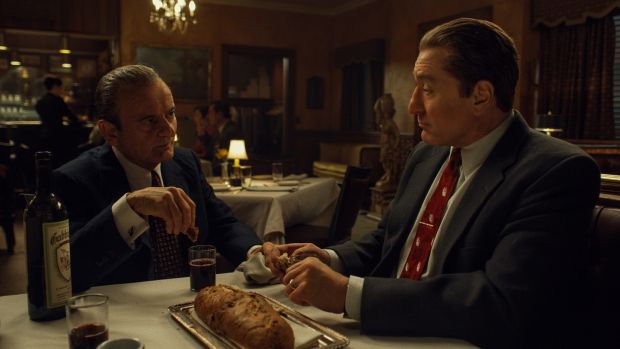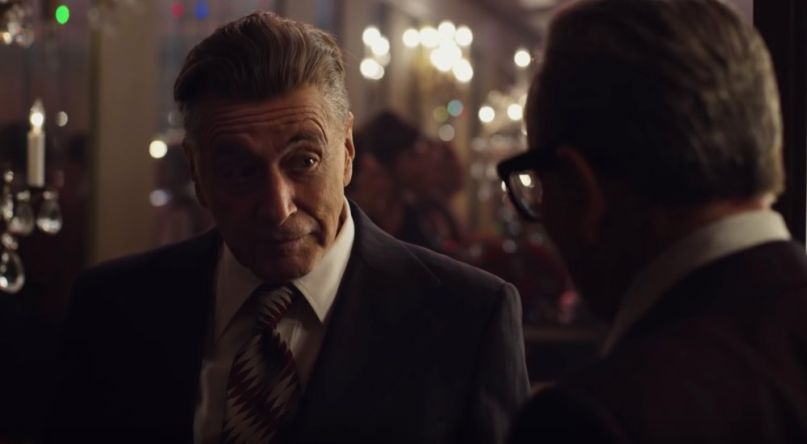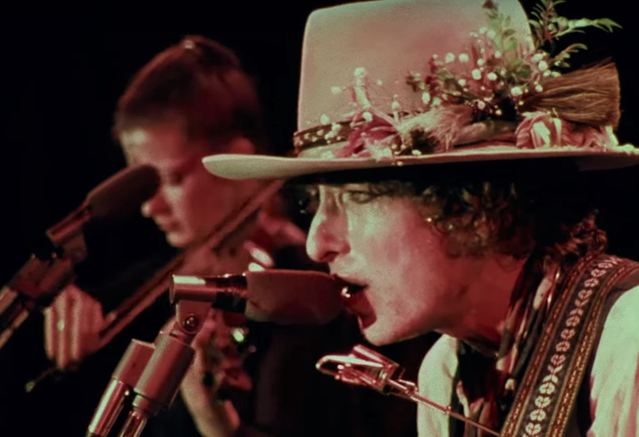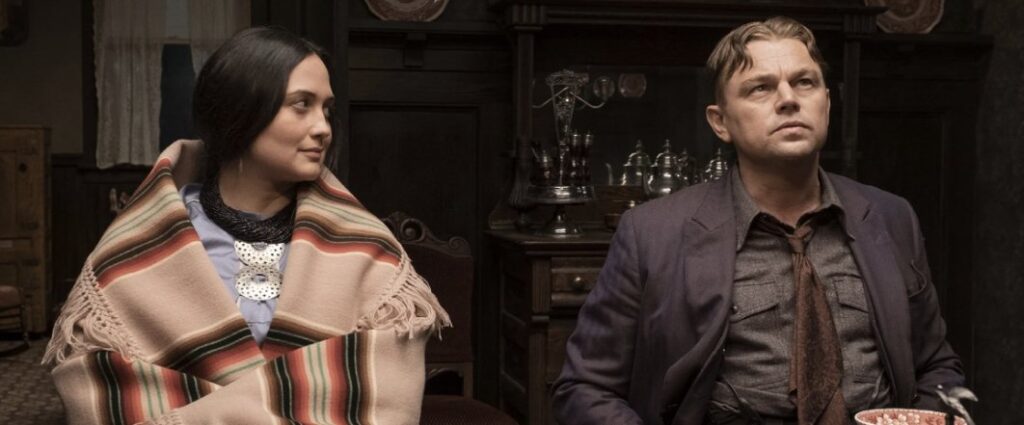
Martin Scorsese’s three-and-a-half-hour Killers of the Flower Moon is an absorbing epic of betrayal, betrayal on many levels.
In the 1920s, the Osage people, having been cast into the apparently worthless dry prairie of northern Oklahoma, have the good fortune to discover oil on their land. Suddenly, tribe members become instant, Pierce Arrow-driving oil millionaires. It doesn’t take long for tribe members to start dying mysterious deaths, with their oil rights passing to local Whites. Despite the entreaties of the Osage, local and state law enforcement is, at best, indifferent, and the bodies pile up.
This a true story that was essentially little known before a 2017 bestseller by David Grann. Osage country in the 1920s is an unfamiliar setting for us, the audience. Scorsese takes the time to bring this society alive for us. Bejewelled Native Americans are consuming luxuries while White men scurry around in menial jobs and hucksterish scams. Lazy nogoodniks are looking for gold-digger marriages to rich Osage women. We’re not that far along from an Old West of saloons, gunfights and Indian Wars, and, despite the new fangled automobiles, there are plenty of working cowboys.
A recent WW I vet, Ernest Burkhart (Leonardo DiCaprio) arrives with few prospects. His uncle William King Hale (Robert De Niro) is an established bigshot, and takes Ernest under his wing. The uncle, who likes to be called King, is a major cattle rancher with a unique and longstanding relationship with the Osage, even speaking the Osage language and having an Osage drinking buddy. King enjoys being a Big Fish in a Little Pond, and is a very wily Big Fish.
Ernest on the other hand, is not at all smart, but he’s amiable and ambitious, and he’s lucky enough to meet Mollie (Lily Gladstone), an Osage woman, and marry up.
Mollie is very smart, a keen and clear-eyed observer of human behavior. She is strong willed and knows what she wants. She only has two vulnerabilities – her diabetes and a (temporary) inability to imagine the depth of someone’s worthlessness.
Gladstone’s performance is especially brilliant as she sizes up Ernest. Mollie is under no illusions about Ernest’s qualities, and she knows that he is attracted to her money. But he’s more good-hearted and less lazy than the other available White men, and he’s much better looking. She knows what she wants, and she knows what she’s getting. Near the end of the film, Mollie asks Ernest a question, and, upon his answer, Gladstone’s eyes silently sum up the entire story, with all its themes. It’s a superb, highly nuanced performance and certainly award-worthy.
DiCaprio ably portrays Ernest Burkhart, a protagonist who is a spineless dimwit. The centrality of Killers of the Flower Moon becomes the story of the weak-willed Ernest, pulled between his much smarter and strong-willed uncle and wife.
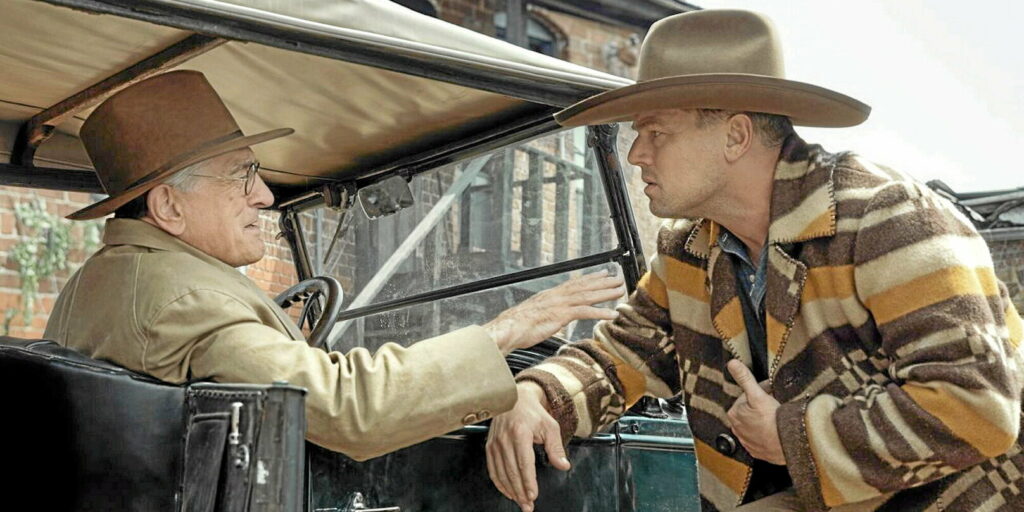
The story starts as a whodunit, but then it’s revealed who is responsible, and we are immersed into the portraits of the three main characters, with the story is framed against the greater themes. One of those themes is the racism that devalues the lives and welfare of Native Americans, and the even more universal human history of the powerful unapologetically taking from the less strong. And then there’s the exploration of trust – just whom can you trust and to what degree?
Heeding the plight of the Osage, the federal government finally dispatches an FBI team, headed by the pleasant but implacable former Texas Ranger Tom White (an excellent Jesse Plemons). The agency is so young that it isn’t yet known as the “FBI” but as the “Bureau of Investigation”. Solving the Osage Murders was an important early benchmark in FBI history (which is emphasized in Grann’s book but not explicit in the movie).
In this case, the villain is a sociopath who can hide in plain sight with audacity, and who recognizes, and is able to leverage, the racism in the environment. Tom White, however, is immune to bullshit, and hones in on the crimes, regardless of who the victims may be. And the villain’s soft underbelly is his reliance on some very dumb henchmen.
Again, this story really happened, and the characters played by De Niro, DiCaprio, Gladstone and Plemmons are actual historical figures. Another writer has noted that’s it’s interesting that, although this is a serial killer movie, Scorsese chose not to focus on either the murderous mastermind nor on the detective trying to corner him. Indeed, I’ve also read that DiCaprio was originally slated for the FBI role, but advocated to make the role of Ernest central enough for him to play.
The cast is impossibly rich, including Oscar winners and nominees De Niro, DiCaprio, Plemmons, John Lithgow, and Brendan Fraser, plus Tantoo Cardinal, who SHOULD have been nominated for Dancing with Wolves, among other work. Scorsese gets memorable performances from Cara Jade Myers, Louis Cancelmi (Billions, The Eyes of Tammy Faye) and Ty Mitchell. One of the most vivid performance is from Tommy Schultz, a guy with no previous screen credits.
One of my favorite musicians, Jason Isbell, plays a key character, and he’s excellent. There’s one scene where Isbell’s and DiCaprio’s characters are isolated in a parlor and have a verbal confrontation. Although DiCaprio’s character has the best lines, it’s an acting standoff, and you really can’t tell that one of these guys is a movie star and the other is just learning the business. Very impressive.
Speaking of musicians, this was the last time Robbie Robertson composed music for a film, and his score is magnificent. Robertson, of course, had been a close friend and collaborator of Scorsese’s since The Last Waltz (and was also a Canadian of Cayuga and Mohawk heritage). Blues harmonica great Charlie Musselwhite and rock star Jack White also have acting cameos.
I rarely mention a movie’s sound mixing, but the extraordinary sound mix when Ernest, in a panic, buttonholes King at a boisterous town street party, strongly contributes to the storytelling.
What of the three hour, twenty-six minute running time? I agree with the critical consensus that Killers is long, but never slow. After all, it is an epic, even several epics braided together.
Killers of the Flower Moon is an excellent movie, and will receive lots of recognition. I’m sure that it will be nominated for a Best Picture Academy Award (although it’s not nearly as good as Oppenheimer IMO) and will garner Oscar nominations for Lily Gladstone and Robbie Robertson, who will be favorites in their categories. Other Oscar nods are likely.
Killers of the Flower Moon is in theaters, and will stream on AppleTV sometime after December 4, perhaps as late as January.

